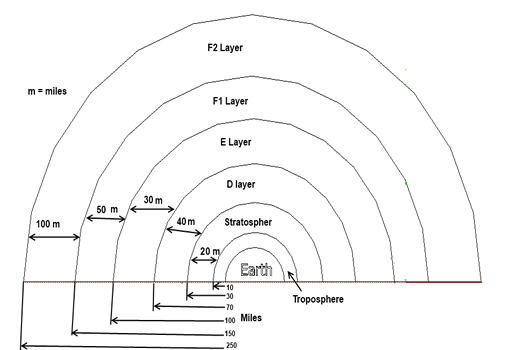Atmosphere
The area from the surface the ground towards the sky all over the earth. These different type of gasses are present is called atmosphere. This atmosphere consists of different types of layer which are explained below.
Layers of Atmosphere
The atmosphere the earth is divided into the following three layers.

Troposphere
As shown in the given diagram, the troposphere is the layer which starts from the surface of the ground and reaches up to 10 miles above the surface towards the conditions of the earth.
Stratosphere
This layer is situated above the troposphere at and it is up to 30 miles from the ground. This layer is composed of different gasses which are heavier near the earth and lighter towards the sky.
Ionosphere
As shown in the given diagram the layers of ionosphere is present above the stratosphere and it is from 30 to 250 miles up from the ground. This layer is composed of positive and negative ions. The ionization of this layer is due to the heat energy of the sun.
Layers of Ionosphere
The ionosphere is sub divided in to following layers
D Layer
This layer is located above the stratosphere. Its range is from 30 miles to 70 miles with reference is the surface of the earth.
The intensity of ionization is higher in the D-layer because it is composed of the heavier gasses.
E Layer
This layer is located above the D-layer. Its range is from 70 to 100 miles, with reference to the surface of the earth. The intensity of ionization is lessor in the E-layer with respect to D-Layer because it is composed of the less heavy gasses with respect to D-Layer.
F1 Layer
This layer is located above the E-Layer. Its range is from 100 to 150 miles with respect to the earth. The intensity of ionization is lessor in the F1 layer with respect to E-Layer because it is composed of the less heavy gasses then the F1 Layer.
F2 Layer
This layer is located above the F1 layer. Its range is from 150 miles to 250 miles with respect to earth. The intensity of ionization is lessor in the F2 layer with respect to F1 layer. Because it is composed of the less heavy gasses then the F2 Layer.
Variation in Ionosphere Layer
The layer of ionospheres changes its width according to the climatic or weather condition. In summer season the F2 layer of ionosphere receiver up to 300 miles because the process of ionization increases due to heat. In summer season as the heat energy is increased with respect to normal climatic condition. Therefore the ionization takes place in those areas above the F2 layer where the lighter gasses are present.
In the winter season the F2 layer decreases up to 200 miles with respect to normal climatic conditions. It is because of fall in temperature which results in less ionization as compare to normal climatic conditions.
Effect of Ionization on Radio wave
When the electromagnetic waves are propagated from transmitter antenna. After propagation these waves travel in a straight line when the radio waves inter the ionosphere, they are under the influence of the layer and the following effects take place.
If the incident angle of the radio wave to the ionosphere is increased the distance covered by the radio waves will increase.
If the intensity of ionization is more than the distance covered by the radio waves will be more.
If the frequency of radio waves is increased the range of the reception will also increase.
